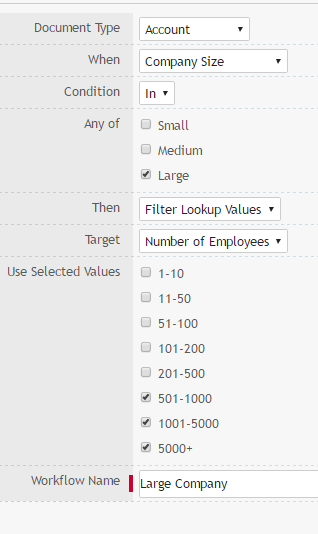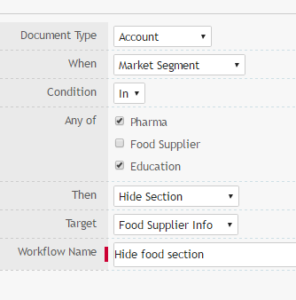Page workflows mean that one custom dropdown controls what values are shown in another custom dropdown or if a custom section is visible or hidden.
ASPEC Administrator can limit the number of Custom Field sections or values in a dropdown Custom Field, based on a value in another Custom Field.
Click Settings in the top right corner of the main navigation bar and open Customize/Workflows link in the ASPEC Setup.
Workflow rules
Workflow rules are similar to if-then statements,
Workflow rules can be broken into the following two main components:
- Trigger: the “if” part of the “if-then” statement. In other words, what must be true of the record for the workflow rule to execute the associated actions.
In ASPEC the Trigger is a change in the value of a Custom Lookup Field.
- Action: the “then” part of the “if-then” statement. In other words, what to do when the record meets the criteria.
ASPEC action fall under one of the two following categories:
- A list of options in a Custom Lookup Field is filtered (Filter Lookup Values)
or
- Custom Section is hidden or displayed (Hide Section)
The Target is the affected Custom Field or Section.
Workflow rules apply to Custom Fields that have been added to the custom field sections. Please read this post for more information how to set up Custom Field sections.
Setting up Page Workflow for Lookup filter
Imagine you have a dropdown Custom Field labelled “Company Size” that has 3 options to choose from: “Small”, “Medium” and “Large”. Another dropdown Custom Field, labelled “Number of Employees”, is used to select the relevant range for the number of employees. If the user selects “Small” in Company Size, then having an option “5000+” does not make sense.
You can provide users with relevant options for “Small”, “Medium” and “Large” as follows.
1. Select Document Type and find the Field in “When”. Select the Condition “In” and check “Small”. You want to limit the list in “Number of Employees”, so select “Filter Lookup Values” and check the options that apply to “Small”. Give the workflow a name and save it.

Fig 1: Selecting applicable values for Small company size
In this case, if the user selects “Small”, the list of available options in Number of Employees is “1-10” and “11-50”. Other values won’t be shown in the dropdown.
2. Repeat Step 1, but now select “Medium” in “Any of” and values applicable to “Medium” in “Use Selected Values”. Give the workflow a name and save it.

Fig 2: Selecting applicable values for Medium company size
In this case, if the user selects “Medium”, the list of available options in Number of Employees is “51-100”, “101-200” and “201-500”. Other values won’t be shown in the dropdown.
3. Repeat Step 1 for “Large”. Give the workflow a name and save it.

Fig 3: Selecting applicable values for Large company size
In this case, if the user selects “Large”, the list of available options in Number of Employees is “501-1000”, “1010-5000” and “5000+”. Other values won’t be shown in the dropdown.
Setting up Page Workflow for hiding section
Imagine you have a dropdown for selecting a Market Segment of the Account. You collect more information for Pharma and Education, but not for Food Supplier. In this case you want to hide one of the sections if Market Segment is not Food Supplier.
The Trigger logic is identical as in the example above. The Action is “Hide Section” and the Target is one of the Custom Field sections configured for the same form.

Fig 4: Hiding a section on Account
A form can have multiple triggers.
Note: the validation rules in imports do not apply workflow rules. Please check prior to performing the import to ensure that correct target values are provided.